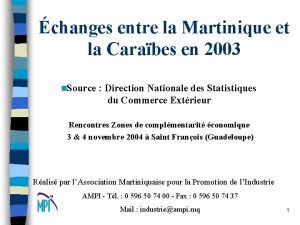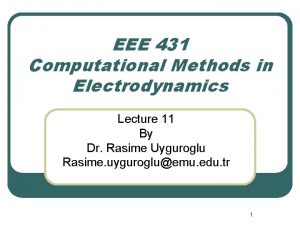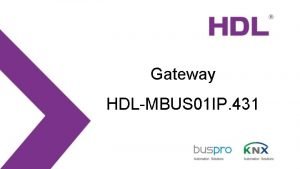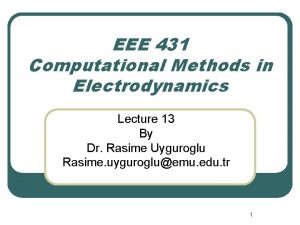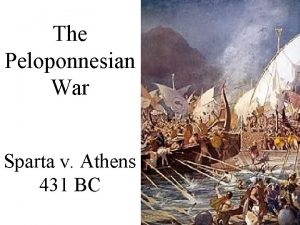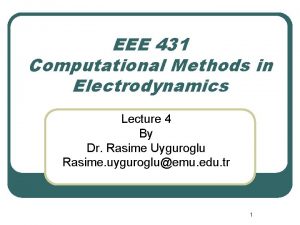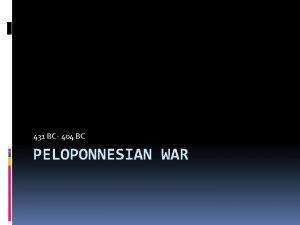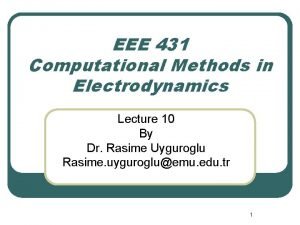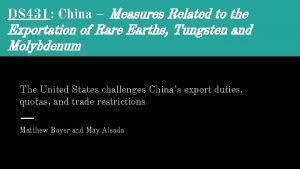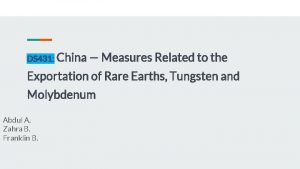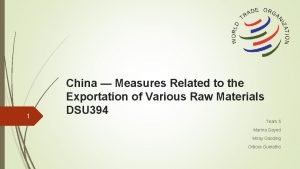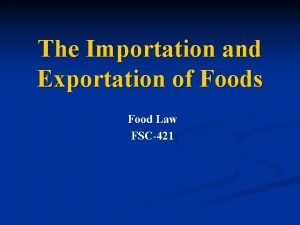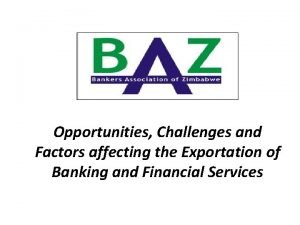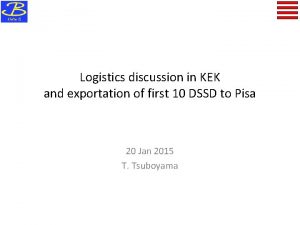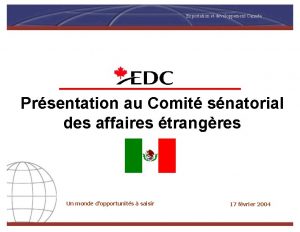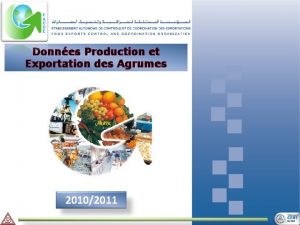DS 431 China Measures Related to the Exportation















- Slides: 15

DS 431: China – Measures Related to the Exportation of Rare Earths, Tungsten and Molybdenum The United States challenges China’s export duties, quotas, and trade restrictions Matthew Boyer and May Alsada

History & Context ● The rare earths trade dispute between the US and China was about China's export restrictions on rare earth elements as well as Tungsten and Molybdenum, which are used to make many electronics. ● The US relies on China for 80% of its rare earth imports. ● China controls 97% of the production of these elements. The US, EU and Japan claimed that the restrictions violate the WTO trade regulations, while China argued that the restrictions are for resource conservation and environmental protection. However, critics stated that the restrictions are protectionism in disguise.

Prior Proceedings ● In 2012, the Obama administration filed a case with the Dispute Settlement Body of the WTO. ● The US claimed that the Chinese restrictions were in violation of the accession treaty that China had signed when it joined the WTO in 2001. The treaty banned export duties and quotas, except for goods explicitly listed. Rare earths were not among the goods in the list. ● In 2014, the WTO ruled against China, which made China drop the export quotas in 2015.

Main Issue, Positions Held, & Final Decision ● The Dispute Settlement Panel ruled against China. Although the Panel agreed that countries are allowed to restrict exports for reasons brought up by China, the Panel was not convinced that the Chinese restrictions served those reasons. ● China's restrictions gave its domestic firms better access to the rare earths, which was against the “non-discrimination” principle that the WTO members have to follow. ● The Appellate Body upheld the Panel's findings that China's export duties, export quotas, and trading rights restrictions on rare earths, Tungsten, and Molybdenum are not justified under Article XX(g) of the GATT 1994.

Contested Issue ● The US argues that China’s restrictions on export duties, export quotas, and trading rights restrictions served its industrial policies. ● Some of China’s measures were unpublished which creates a transparency issue. ● Such unsteady relations between the U. S. and China have affected trade in very specific ways. ● The dispute is frequently cited by business executives and analysts as one of the major threats to the global economy. ● The American news program 60 Minutes broadcast a segment on the dispute in which the news anchor said that, due to the extensive use of the rare earths, particularly in weaponry, the Chinese restrictions created a national security threat to the US.

WTO Agreement & Provisions ● Pertaining to the final decision: ○ ○ GATT Articles: XI, XX(b), XX(g) China’s Accession Protocol Working Party Report Marrakesh Agreement ● Other agreements/provisions cited in the case: ○ GATT Article VII: ■ ○ GATT Article VIII: ■ ○ Valuation for Customs Purposes Fees and Formalities Connected with Importation and Exportation GATT Article X: ■ Publication and Administration of Trade Regulations

China’s Export Duties & GATT Article XX ● Article XX – General Exceptions ○ ● China: ○ ○ ● “Subject to the requirement that such measures are not applied in a manner which would constitute a means of arbitrary or unjustifiable discrimination between countries where the same conditions prevail, or a disguised restriction on international trade, nothing in this Agreement shall be construed to prevent the adoption or enforcement by any contracting party of measures: ” “(b) necessary to protect human, animal or plant life or health; ” Pollution caused by mining products Complainants: “General Exceptions” in Article XX not available to justify China’s actions, which breach China’s Accession Protocol (obligation to eliminate export duties) ■ And, said duties were not necessary to achieve above health goal

China’s Export Quotas & GATT Arts. XI, XX ● GATT Article XI – General Elimination of Quantitative Restrictions ○ ● “No prohibitions or restrictions other than duties, taxes or other charges, whether made effective through quotas, import or export licences or other measures, shall be instituted or maintained by any contracting party on the importation of any product of the territory of any other contracting party or on the exportation or sale for export of any product destined for the territory of any other contracting party. ” GATT Article XX(g) – General Exceptions ○ ○ “Subject to the requirement that such measures are not applied in a manner which would constitute a means of arbitrary or unjustifiable discrimination between countries where the same conditions prevail, or a disguised restriction on international trade, nothing in this Agreement shall be construed to prevent the adoption or enforcement by any contracting party of measures: ” “(g) relating to the conservation of exhaustible natural resources if such measures are made effective in conjunction with restrictions on domestic production or consumption; ”

Trading Restrictions & GATT Art. XX(g) ● China’s trading rights restrictions included: ○ ○ ● China’s defense: GATT Article XX(g) – General Exceptions ○ ● “(g) relating to the conservation of exhaustible natural resources if such measures are made effective in conjunction with restrictions on domestic production or consumption; ” Working Party Report: ○ ● Minimum registered capital, prior exports experience, and export performance Specific to exporting enterprises of rare earths, tungsten, and molybdenum Paras. 83 & 84 require China to progressively liberalize trading rights (foreign & domestic) China failed to make their case – justifying their breach of WTO obligations and utilization of Art. XX(g) exceptions ○ China had to justify their trading rights restrictions separately from their export quotas

Other Agreements Cited in the Case ● ● GATT Article VII: Valuation for Customs Purposes GATT Article VIII: Fees and Formalities Connected with Importation and Exportation GATT Article X: Publication and Administration of Trade Regulations Specific paragraphs of China’s Accession Protocol, Part 1: ○ ○ ○ 2(A)2: Administration of the Trade Regime; Uniform Administration (impartiality of trade laws) 2(C)1: Administration of the Trade Regime; Transparency (access to published trade laws) 5. 1, 5. 2: Right to Trade (progressively liberalizing trade, foreign & domestic, w/o preferential treatment) 7. 2: Eliminating unjustified non-tariff measures 8. 2: Foreign individuals/enterprises accorded no less treatment 11. 3: Elimination of taxes & charges for exports

China: Consistent or Inconsistent w/Obligations? ● (1) Export duties – Inconsistent ○ ○ ● (2) Export quotas – Inconsistent ○ ○ ● Breach of obligation to eliminate export duties – China’s Accession Protocol China could not evoke Article XX(b) exception to justify duties Duties not “necessary to protect human, animal, or plant life or health” AB upheld the Panel and found that: the Marrakesh Agreement, Multilateral Trade Agreements, and China’s Accession Protocol form a single package of rights/obligations and must be read together China’s export quotas were not justified under Article XX(g) of GATT Found that China’s quotas were not intended for conservation but rather industrial policy This measure controlled global market of this natural resource, contrary to obligations Overall impact – foreign & domestic restrictions – enabled preferential treatment for Chinese manufacturers (evenhandedness) (3) Restrictions on tradings rights of exporting enterprises – Inconsistent ○ ○ China could rely on Article XX(g) exceptions to justify restrictions, but China did not provide enough evidence/explanation to prove this Therefore, China was inconsistent with their WTO obligations

Implementation of Recommendations/Rulings ● ● ● DSB adopted AB report & Panel report (August 29, 2014) China informed of intention to implement recommendations and rulings in reasonable time (September 26, 2014) U. S. & China agree to reasonable time of implementation – 8 months and 3 days from date of adoption (December 8, 2014) Implementation time expired (May 2, 2015) China informed of full implementation of DSB’s recommendations and rulings (May 20, 2015) ○ Full removal of export duties, export quotas, and trading rights restrictions on exporting enterprises – relating to rare earths, tungsten, and molybdenum

Observations: ● China assumed/argued a very narrow international legal interpretation of obligations across all agreements ○ Panel and AB ultimately ruled that the following had to be read as one single package and not separately: Marrakesh Agreement, the Multilateral Trade Agreement, and China’s Accession Protocol ● Illustrates need for precise language and dispute context in terms of linkages between agreements/obligations ● The increased economic impact of goods-specific disputes in light of globalization (EX: importance of rare earths trade between two major economies) ● Importance of third parties in dispute settlement to expand scope of evidence (and can assist in de-escalation & avoidance of trade wars) ● Illustrates continued and growing concerns regarding China’s State-Owned Enterprises (and more generally preferential treatment and use of subsidies)

Questions?

Bibliography ● “ACCESSION OF THE PEOPLE'S REPUBLIC OF CHINA. ” World Trade Organization, 23 Nov. 2001. file: ///Users/mboyer/Downloads/432. pdf ● “Background Information on China's Accession to the World Trade Organization. ” USTR, 11 Dec. 2001, ustr. gov/archive/Document_Library/Fact_Sheets/2001/Background_Information_on_China's_Accession_to_the_World_Trade_Organization. html. ● DS 431: China — Measures Related to the Exportation of Rare Earths, Tungsten and Molybdenum. World Trade Organization, 2015, DS 431: China — Measures Related to the Exportation of Rare Earths, Tungsten and Molybdenum, www. wto. org/english/tratop_e/dispu_e/cases_e/ds 431_e. htm. ● Summary of key findings for DS 431 of the WTO including Appellate Body Report and Panel Report. ● “General Agreement on Tariffs and Trade 1994. ” World Trade Organization, GATT, 1994. Must be read with GATT 1947. ● “REPORT OF THE WORKING PARTY ON THE ACCESSION OF CHINA. ” World Trade Organization, 1 Oct. 2001. file: ///Users/mboyer/Downloads/CHN 49. pdf ● “The Text of The General Agreement on Tariffs and Trade (GATT). ” World Trade Organization, July 1986.

